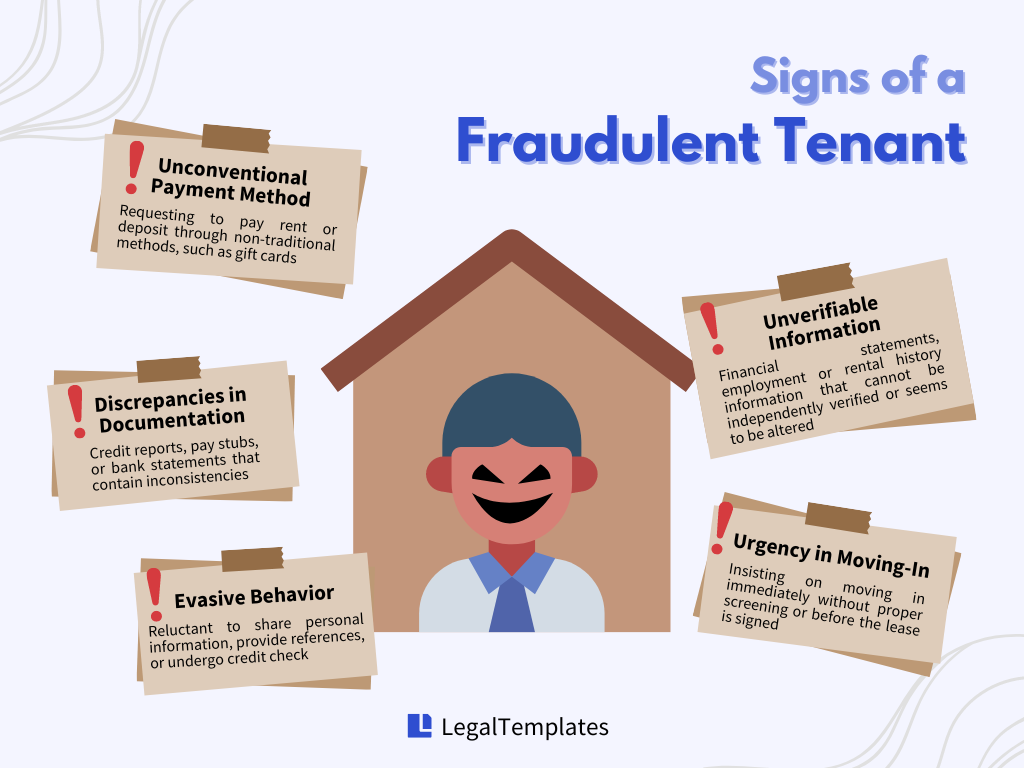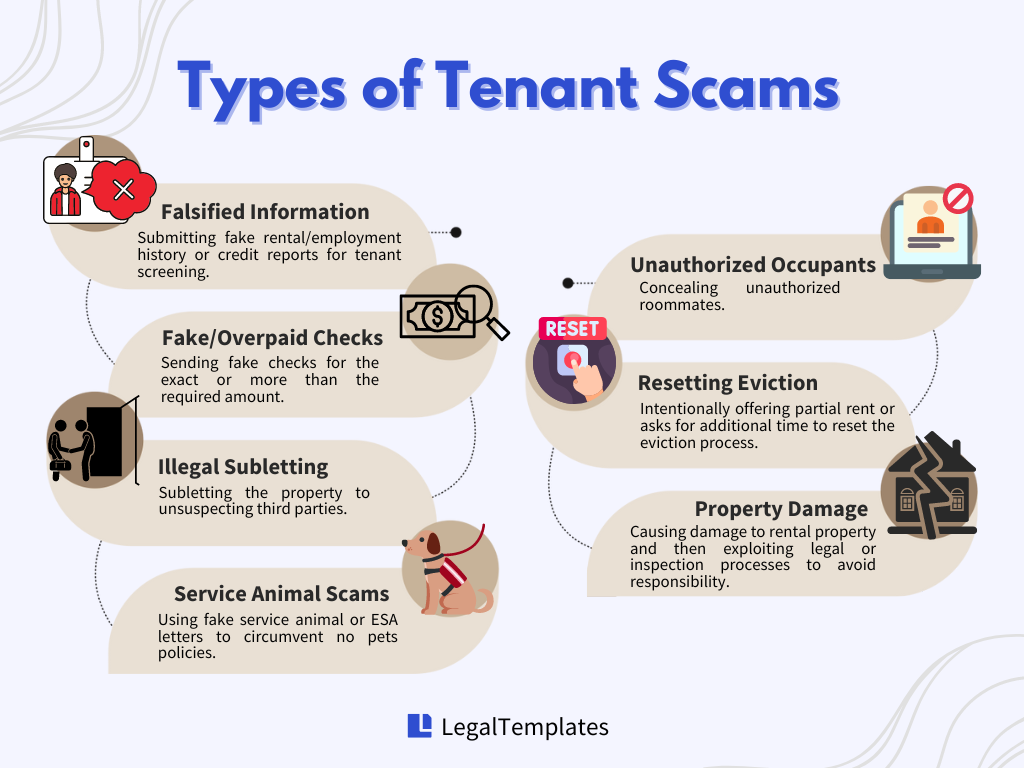
Have you ever considered the potential havoc tenant fraudsters could wreak on your property investment?
Tenant fraud can lead to significant financial losses, property damage, and complex legal dilemmas for landlords. Rental scams aren’t just stories; they impact real people and could impact you. Understanding and identifying the warning signs of a fraudulent tenant is your first line of defense.
This guide equips you with the knowledge to detect deceptive tenants, strategies to avoid rental scams targeting landlords, and advice on what to do if you’ve fallen victim to a scam.
Signs of a Fraudulent Tenant
Landlords and property managers can safeguard their properties by recognizing signs of deception and implementing preventive measures. Here are some key signs of a fraudulent tenant:

- Discrepancies in Documentation: Watch for credit reports, pay stubs, and bank statements that contain inconsistencies. Examples of inconsistencies in documentation include transposed numbers or details that don’t align with verbal disclosures.
- Urgency in Moving-In: Be wary of potential tenants who want to move in immediately before signing the lease or without a rental application or proper screening. These individuals often apply pressure to accept them quickly and may fabricate stories to evoke an emotional response.
- Evasive Behavior: Prospective tenants who are reluctant to share personal information, provide references, or undergo a credit check during the screening process may plan to engage in fraudulent behavior.
- Unverifiable Information: Be cautious of tenants providing financial statements, employment details, or rental history information that can’t be independently verified or appears to be altered.
- Unconventional Payment Methods: Watch for tenants who ask to pay rent or security deposits through non-traditional means, such as gift cards, foreign currency, cryptocurrency, or personal checks from unverified accounts. Their payment method may not go through, allowing them to live rent-free.
Remember, tenant fraudsters can be crafty, but you can protect your investment with thorough tenant screening, including checks on employment, rental history, and references. To prevent unwanted disputes, always include specific language regarding providing false information in the screening application and lease agreement.
► READ MORE: Top 10 Red Flags on Rental Applications
7 Common Tenant Scams and How to Prevent Them
As a vigilant landlord or property manager, you’ll need to navigate the murky waters of tenant fraud.
Here are seven common tenant scams targeting landlords and how to prevent them:

#1: Falsified Information
What Happens
Some applicants might lie about their rental history to cover up past evictions. Tenants lacking stable income may fabricate employment records or even pay stubs. Others may present a fabricated credit report to disguise their poor credit scores and financial situation.
How to Prevent
-
Conduct independent background and credit checks. Use reputable tenant screening services to verify employment and rental history and independently pull credit reports. These processes ensure the authenticity of the applicant’s financial and personal background.
- Ensure you obtain the tenant’s authorization before conducting a thorough background check and obtaining credit reports.
- Verify information with employers directly. Rather than taking the tenant’s word for it, contact the purported employer directly to ask about the claimed employment.
- Request additional documentation. Ask for pay stubs, employment letters, bank statements, and W-2 forms to comprehensively assess the tenant’s financial health and verify employment history. Examine these documents for consistency in employer details, salary figures, and professional presentation.
- Scrutinize pay stubs. Quite a few websites generate fake pay stubs and W2 forms for a small fee. Look for red flags in pay stubs, such as rounded income figures or missing professional details like the employer’s name, address, and logo. Fake pay stubs often lack the sophistication of genuine documents, betraying their illegitimacy. [1]
Fake Pay Stubs
Individuals counterfeiting pay stubs may face criminal and civil charges. If you spot a suspicious pay stub, report it to the FTC.
► READ MORE: How to Run a Credit Check on a Tenant
#2: Fake or Overpaid Checks
What Happens
Paying rent or security deposits with counterfeit checks, sometimes drawn on reputable banks or financial services, is a common rental scam among tenant fraudsters. Tenant scammers may provide fake checks or intentionally provide a check for more than the required amount and then request a refund.
By the time the landlord discovers the tenant’s fraudulent nature, they must navigate financial losses, potential evictions, or property damage.
How to Prevent
- Implement a strict overpayment policy. Never accept overpayments. If an overpayment occurs, return the check and request the correct amount.
- Add an overpayment provision in the lease. Incorporating specific provisions within the lease can preemptively address and prevent rent overpayment scams. Decide how to handle overpayment, such as applying excess funds to future rent or returning overpayments at the end of the lease.
- Wait for check clearance. Before considering any refund, ensure the check has thoroughly cleared. This process involves receiving the bank’s initial confirmation of available funds and considering the additional time required for the check to clear completely according to legal and banking regulations.
- Cash a check before granting access. If the tenant gives a check for a security deposit or rent, deposit it before giving property access.
- Learn to identify fake checks. Look for authentic security features (e.g., watermarks and color-changing ink), the material, the number, and other check details. [2]
#3: Illegal Subletting
What Happens
This scam involves a tenant renting your property without intending to reside there themselves. Instead, they sublease it to unsuspecting third parties, often collecting rent upfront and not forwarding these payments to the landlord.
While subleasing is legally permissible when outlined in the lease terms, problems arise when tenants do so without the landlord’s knowledge or consent.
How to Prevent
- Establish clear lease terms. Ensure your lease agreement explicitly prohibits or strictly regulates subletting. Write a clause that requires the tenant to seek the landlord’s consent before they can sublet.
- Highlight the consequences of unauthorized subletting. Inform tenants of the legal actions you will take if they breach the lease agreement regarding subletting. Making the consequences clear can deter tenants from considering unauthorized sublets.
- Perform regular inspections. Schedule regular visits to exercise your right to inspect the property. Inspections help you identify if occupants other than those on the lease live on your property.
- Promptly address late payments. Late rent payments can be an early indicator of potential subletting scams. Utilize online rent payment services that notify you of late payments and report to credit bureaus to maintain a record of the tenant’s payment behavior.
- Monitor online listings. Look for your property on platforms like Craigslist or Airbnb, as tenants might list it without your consent.
#4: Service Animal Scams
What Happens
Tenants may use fake service animal or Emotional Support Animal (ESA) letters to circumvent no-pet policies. Tenants attempt to bypass restrictions, fees, or deposits associated with pet ownership by claiming they need a service or emotional support animal.
While landlords can establish no-pet policies to protect their property and ensure peace for all tenants, the misuse of service animal and ESA designations poses a significant challenge. Fake ESA letters can leave landlords without recourse for pet-related damages, as these animals may not have the training or temperament of genuine service or support animals.
How to Prevent
- Implement clear policies. Incorporate detailed pet and service animal policies within your lease agreements and advertisements. Although you cannot inquire about the nature of a tenant’s disability, you can request legitimate verification of a service animal’s status.
- Understand legal exemptions. Familiarize yourself with the Fair Housing Act [3] and related landlord-tenant laws to determine if your property might be exempt from certain anti-discrimination requirements. [4]
- Verify the letter. For tenants in non-exempt properties, you can require ESA or service animal letters to be issued directly from a licensed mental health professional. Contact the health care provider or verify their license online. You can also examine the letter to see if it meets the necessary criteria of a legitimate ESA letter. [5]
► READ MORE: Pets and Emotional Support Animal Addendums to Lease Agreements
#5: Concealing Unauthorized Occupants
What Happens
Sometimes, the primary tenant seeks to reduce living expenses by having roommates. However, problems occur when these roommates are not disclosed to the landlord, possibly due to their undesirable rental history or criminal background.
Unauthorized roommates can result in many issues for landlords, including overcrowding, insurance liabilities, and difficulties with eviction proceedings if they become necessary later.
How to Prevent
Implement a comprehensive application process. Require all potential adult occupants to apply and undergo a thorough tenant screening process.
- Write clear lease terms. Explicitly state in the lease agreement that any breach, including the harboring of unauthorized occupants, could lead to lease termination. Make sure tenants are aware of the consequences of violating the lease.
- Clarify the guest policy. The lease should define clear guest policies, specifying how long guests may stay before they must be added as official tenants.
- Conduct regular inspections. Conduct regular, but always announced, property inspections to stay informed about who is living in the unit.
- Facilitate strong landlord-tenant communication. Foster an open line of communication with your tenants. Encourage them to discuss any changes in occupancy or potential roommates. A good relationship can lead to better compliance with lease terms.
#6: Resetting Eviction
What Happens
During the eviction process, if you accept a partial or late rent payment from the tenant or agree to requests for additional time in the property, this action can legally reset the eviction process.
Consequently, you must begin the eviction procedure from scratch, including re-serving notices and re-filing paperwork, which extends the time and increases the cost of regaining possession of the property.
How to Prevent
- Understand local eviction laws. Familiarize yourself with the eviction laws in your state to ensure compliance with the required procedures and timelines.
- Don’t make exceptions to accepting partial payments. Once you have initiated the eviction process, do not accept any partial or late rent payments from the tenant unless you are prepared to stop the eviction.
- Clearly communicate with tenants. If local laws permit, inform tenants in writing that accepting payment does not waive your right to continue with the eviction.
- Document everything. Keep detailed records of all transactions and correspondence with the tenant during the eviction process.
- Consider a cash-for-keys agreement. As an alternative to formal eviction, consider offering a cash-for-keys agreement, where the tenant agrees to voluntarily vacate the property in exchange for a specified sum of money.
#7: Property Damage
What Happens
Some tenants may deliberately cause damage to the rental property and then exploit legal or inspection processes to avoid responsibility. They might report unaddressed repairs to licensing and inspections departments, leveraging any issued violations to justify withholding rent.
Additionally, upon moving out, tenants may attempt to conceal damages to recover their full security deposit, employing superficial fixes that mask the true extent of the damage.
How to Prevent
- Conduct thorough tenant screening. Conduct comprehensive screenings of potential tenants, including contacting previous landlords to inquire about past behaviors related to property care and financial responsibilities.
- Inspect the property carefully. Complete a detailed property inspection report before a tenant moves in and after they move out. Regular inspections during the tenancy are also crucial to document the property’s condition over time. Perform these inspections with the tenant present, allowing both parties to agree on the property’s condition at each stage.
- Distinguish normal wear and tear from true damage. Understand and communicate to tenants the difference between acceptable wear and tear and actual damage.
- Handle the security deposit appropriately. Avoid refunding the security deposit before conducting the final property inspection.
What to Do If You’re a Victim of Tenant Fraudsters
Step 1 – Collect Evidence
Gather all evidence of the scam, including any relevant correspondence between you and the tenant and other documentation that proves lease violations.
Step 2 – Issue a Notice
Send a written notice to the tenant. The notice must clearly outline:
- The specific lease violation;
- The required action to remedy the breach;
- (If applicable) the deadline to cure the breach (usually 7-14 days, depending on state laws); and
- (If applicable) the consequence if the tenant fails to address the issue by the specified deadline.
If your lease agreement is well-drafted, any of the scams mentioned above should constitute a lease violation.
Step 3 – Report to Relevant Authorities
If the scam involves falsification constituting a criminal activity, such as forged documents or pay stubs, report the incident to the FTC and other local authorities. If the scam involved a fabricated credit report, inform the credit bureaus about the incident.
If you have suffered financial loss from the scam, report the fraud to the police to obtain an official record of the incident, which can help recover lost funds and/or prosecute the scammer.
Step 4 – Notify Relevant Parties
If the scam involves a fake check, contact your bank immediately and ask about the next steps.
In the case of illegal subletting, try to communicate with the unauthorized occupants if possible. They may be unaware of the illegal sublet and might voluntarily vacate the property. If you find an unauthorized sublet listed on Airbnb, Craigslist, or another platform, report the listing to have it removed.
Step 5 – Evict the Tenant
If your tenant fails to correct their lease violation within the specified period, you should consider evicting them.
Depending on your state, you may have to give the tenant an appropriate notice period before evicting them for non-compliance. Make sure you clearly state on your eviction notice:
- The names of both parties;
- The date the original lease was signed;
- The reason for eviction;
- The date and time the tenant must cure the violation or vacate the property.
Can the landlord evict a tenant if they submitted falsified information during a rental application?
Yes. If a tenant lists false information on their application, a landlord can legally evict them. This act of deceit can be considered fraud, violating the lease terms where tenants must certify the truthfulness of their information.
Step 6 – Legal Proceedings
If the amount of financial loss incurred from the scam falls within the limits of small claims court, pursuing a case with sufficient evidence against the tenant can be a way to recover your losses.
Conclusion
Avoiding tenant scams is possible when landlords and property managers are vigilant, can recognize warning signs, and take proactive steps.
Knowing how to respond if scammed is crucial for quick recovery. Landlords can minimize risks and maintain a secure, profitable rental environment by staying informed and implementing these strategies.
